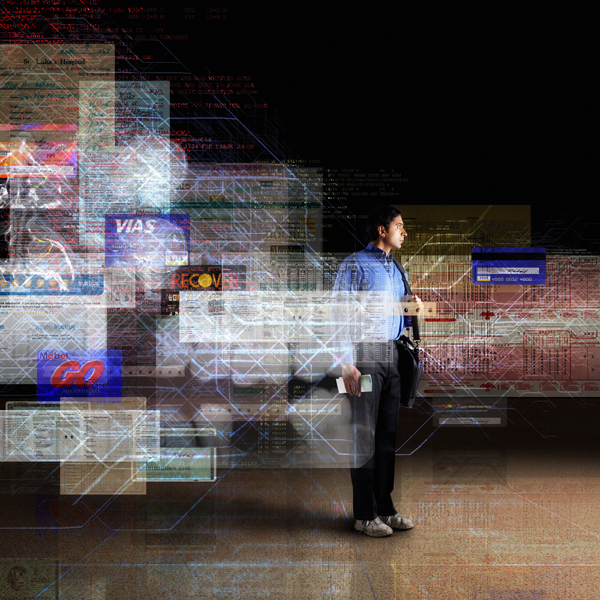3. A father covertly exploits his young son's personal data to meet the demands of the family's lifestyle. This ploy escalates beyond the father's control, until he is compelled to disappear. His wife and son are left with a starkly diminished data portrait, and his escape is shadowed by the long reach of the datasphere.
Video streaming: Traveller Scene 5
Marianne Weems
Nick Kaye: I also thought it was very interesting that SUPER VISION employed an explicitly cinematic frame, but unlike other Builders Association performances where the screen is usually above the performer – here it is dropped down to frame the live performers. How did that evolve?
Marianne Weems: Well that was a huge point of discussion and the ultimate contribution of Stewart Laing, who I think knows all our work and actually contributed to the set design for ALLADEEN partially -- his suggestion was to bring the screen forward, but still above the actors. What I wanted to do in SUPER VISION - and what I kept saying to anybody who would listen to me - was that I wanted to enmesh the performers in the media. That was my goal - and Stewart did that brilliantly by collapsing the video space into the stage space. So there wasn’t feeling that you had in our other performances where the viewer is tracking back and forth between the real live performer and the mediated image. It was really was about trying to combine those as intimately as possible.
Nick Kaye: Is that integration the kind of direction you will continue to go in - or is it something specific to this show?
Marianne Weems: If I wanted to keep going and I had all the money in the world? Yes, that is the direction I would go in. This complicating the presence of the performers has always been our direction, and this piece in particular succeeded. And it was also made very palpable for the audience - you could feel that the performers were really being extended into the media and vice versa, because of the way that they are lined up on a one-to-one scale.

Rizwan Mirza, the traveller
Image by dbox
Nick Kaye: Did you specifically think about this as complicating presence?
Marianne Weems: I did. I am just a perfect subject for you! Again, what came first in SUPER VISION was the idea that we are dragging another body behind us - this electronic network that is extending out of us in some way or flying around us constantly - and how to make that palpable and visual. The more it seemed like the performers were really being invaded by that - or overlapping with the electronics – the more interesting it became.
Nick Kaye: It was very interesting that you could see the performers through the projections of the furniture. I thought that translucence was very important to the integration of the performers into this virtual environment.
Marianne Weems: Yes, the translucence was fun. Everybody knows that it is a chair and a table, it’s a 'prop' in a 'theatre set.' But with these animations, the backdrop is so real, you can have other things floating in and out of it - and they can remain just a sign of what they should be.
Moe Angelos
Nick Kaye: Listening to what you are saying, the performance seems to have a structure that produces a particular kind of awareness for you in what you are doing. Do you find that this structure affects or shapes your sense of presence as a performer in the space or in the role?
Moe Angelos: Well, since my role is almost entirely on camera I am playing to camera. It is very different from being in a play. I don’t have to do a lot, and I don’t have to be big in my body. I can be more restrained, also because of the microphone. The microphone is very subtle: it picks up when I sigh. So I would say my ‘presence’ is both. I am very aware that these instruments are amplifying me – my presence. I would say my presence is more restrained - almost, subtle, small: I don’t have to do a lot. It is not a lot of heavy lifting, as an actor. My presence - my actual presence - is more restrained, but made large by the technology. The technology blows it up, expands it. Does that answer your question?
Nick Kaye: In watching SUPER VISION I think of your presence as dispersed across these things, not just you. In fact, the mediation has a curious reverse effect, because your presence at the desk is in contrast to all the things that amplify you. In a way, I seem more aware of your live presence as a consequence of your amplification. It provides for a curious amplification of both. I think this takes us back to what Norman Frisch was saying about the cyborg.
David Pence
Nick Kaye: Do you feel your presence as a performer in the technology? Or do you feel separate from it?
David Pence: I think I’m aware of both almost continuously. I am aware of myself as a physical human being in the way any actor in a show feels himself on the stage: light on my skin, a lot of people out there, another actor to look at or talk to—maybe. Those are really the tactile realities that are just about being alive onstage. But also, I feel that I am inside that technology and being delivered through that technology. And this is a sensation I don’t want to lose, because I treasure it. I feel—and again I sort of personalise it—I feel safe, as if Marianne is presenting me. It’s like I’m part of a beautiful machine.
see also: acting | data body | double consciousness | interactivity | presence on stage |
SUPER VISION credits




